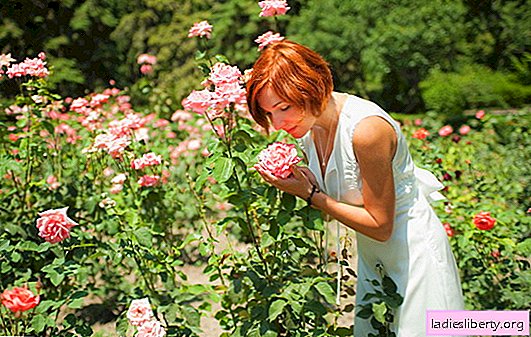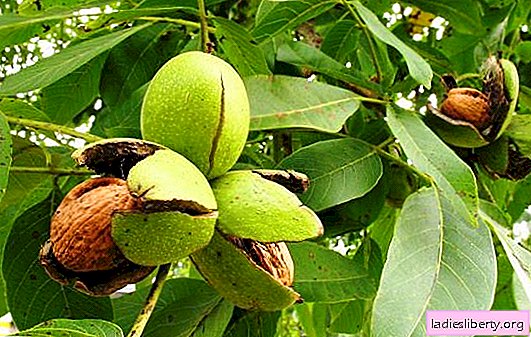
As a queen of flowers, a rose makes "royal" demands on growing conditions.
Nevertheless, gardeners have the opportunity to choose from the wide variety of this plant the varieties and species that are optimal for their region.
Landing place
Roses are demanding to the place of planting. The plot for these flowers should be well warmed up and lit by the sun. In the shade, their growth slows down, shoots are extended, flowering is weak.
Lowlands also will not work: stagnation of air and high humidity contribute to the defeat of roses by fungal diseases. Such areas need to be drained, beds on them make elevated.
It is better to plant roses in a territory with a slope (8-10 degrees) in a south, southwest or southeast direction. At the same time, roses do not tolerate drafts, and strong winds can damage tall bushes and increase moisture evaporation.
The soil
Roses do not like stagnation of moisture in the soil, so light loams and chernozems are suitable for growing them. Clay heavy soils are enriched with sand, rotted manure, peat compost. In sandy loam roses, the root system may freeze in winter and overheat in summer.
To improve such soils, humus, peat, and turf soil are introduced into them. Roses prefer to grow on slightly acidic soils (pH 5.5-6.5).
Growing roses from cuttings
Cuttings are considered among flower growers the most simple and popular way of propagating these flowers. Its effectiveness depends on the variety and type of rose. In comparison with grafted plants, rooted plants are better adapted to the growing conditions and soil composition, live longer, and do not give wild shoots.
Roses are the easiest to root:
• climbing;
• miniature;
• polyanthus and their hybrids;
• Floribunda;
• tea hybrid.
For cuttings using lignified and semi-lignified shoots.
Harvested lignified cuttings when autumn or spring pruning, you can also use broken shoots for this. Store them at a temperature of about 0 ° C. Before planting, such cuttings must be rooted, for example, Burrito method (it gives a small percentage of lunge, does not require much time):
1. Healthy clean shoots are cut into pieces of 15-20 cm.
2. The upper straight section is made in the middle between 2 kidneys, the lower oblique is immediately below the lower kidney.
3. The prepared bunch of cuttings is wrapped in a newspaper, moistened with water, placed in a bag and stored at a temperature of +18 ° C.
4. After 2 weeks, deploy and check for the presence of callus. If it is not, then again removed.
5. After 3-4 weeks, roots appear.
6. Cuttings are planted in the ground, deepening to the first kidney. Put a plastic bottle or mini-greenhouse on top.
To stimulate the rooting of cuttings, you can soak in a heteroauxin solution or root.
Instead of growth stimulants, you can use willow infusion. To do this, chopped pieces of green or yellow willow shoots are placed in a glass and fill with hot water to half their height. After a day, the infusion is ready for use. This infusion can be watered planting young roses.
Semi-lignified cuttings root better. They are harvested during the formation of buds and at the beginning of flowering. To do this, take the middle part of the selected shoot. It is cut into pieces 7-10 cm long with 2-3 kidneys. The upper cut is made straight, the lower - at an angle of 45 ° immediately under the kidney. To reduce the evaporation of moisture, the lower leaves are torn off, the remaining leaves are cut in half.
On the eve of planting, the cuttings should be soaked in a root formation stimulator (BiocloneBAC, BioRoots, etc.). The substrate should consist of turf, leafy soil, sand and humus (4: 1: 1: 2). Prepared soil mixture is poured into the holes in the bed, planted cuttings at an angle and covered with river sand.

Seedlings watered with a potassium permanganate solution, cover each stalk with a plastic bottle or make a mini-greenhouse for the entire garden. Rooted cuttings leave for the winter covered with a layer of insulation material. Transplanted to a permanent place next spring.
Roses from seeds - growing
Rose seeds are grown mainly to produce new varieties. Not all types of roses can be grown in this way: plants obtained from seeds may not retain varietal characteristics. Red-leafed, wrinkled, sparkling, cinnamon roses, ordinary dogrose are easily propagated by seeds.
Planting material can be bought or collected from your favorite bush. With self-harvesting, the fruits must be taken unripe, because seeds from them have the best germination. The seed fruit is cut into halves, the seeds are pulled out and disinfected for 20 minutes in a pharmacy solution of hydrogen peroxide.
Growing roses from seeds at home
In nature, rose seeds undergo natural stratification, therefore, to obtain seedlings at home, you need to create similar conditions:
1. A moisture-retaining material (for example, gauze) is placed in a bowl, seeds are laid on it in one layer, covered with a moist cotton pad and put away in a bag.

2. The whole structure is placed on the lower shelf of the refrigerator (temperature + 5-7 ° C) and left there for about 2 months.
3. Periodically, the film is opened for ventilation and inspection of the seeds.
4. Once the seeds have hatched, they are planted in peat pots and grown at + 18-20 ° C.
Sprouts need 10 hours of daylight (if necessary, it will have to be lightened).
Before spring planting in open ground, seedlings are hardened, gradually increasing their stay in the fresh air. Such plants will bloom in full force next year.
Growing roses from seeds in the garden
If there is a sufficient number of seeds and research excitement, then you can plant them in August in the garden. In the northern regions, crops are mulched with dry leaves or straw, covered with covering material (for example, lutrasil), and snow is poured on top. In April, shelter is removed. If frost is predicted, then a small greenhouse is installed above the garden.
Roses grown from seeds in open ground are well adapted to environmental conditions,
Roses: care
In caring for roses, they carry out the same activities as for other flowers: watering, loosening and mulching the soil, top dressing, weeding, pest control, winter shelter. In addition, some types of roses need pruning.
Trimming and shaping bushes
Pruning roses is needed for regular rejuvenation, bush formation and stimulation of flowering.
This operation is carried out according to the following rules:
• pruning is carried out annually in dry weather;
• used tools must be well-sharpened and disinfected;
• cuts are treated with garden varieties;
• cut the stems to a healthy tissue.
Dates of pruning roses
Spring pruning - the main one. It is held annually during the period of kidney swelling. All damaged by frost, sick, weak branches are removed to healthy wood.
With summer pruning shorten fat shoots without buds, cut stems thickening the center of the bush, faded flowers. This will stimulate the plant to a new flowering. In grafted roses, wild root shoots are cut out.
Autumn pruning associated with the need for winter shelter of bushes.
Watering
Roses are watered abundantly once a week, under the root. In the hot summer season, watering is increased and carried out in the morning and evening. About one bucket of water is consumed per bush. From the second half of August, watering is reduced, and in September it is completely stopped.
Soil cultivation and mulching
Loosen the earth under rose bushes after rains and watering to destroy the soil crust and improve aeration. The depth of cultivation should be small (5-10 cm), otherwise the upper roots can be damaged, which will negatively affect the development of the plant.
In the spring, before the buds open, the first mulching of roses is carried out. To do this, apply humus, straw, husk of seeds. Weeds are preliminarily weeded, watered and loosened the earth, fertilizers are applied. Before autumn frosts they mulch repeatedly.
Preparing roses for winter and shelter
Depending on the variety and species, roses need winter shelter. Park roses are the most winter-hardy. For wintering, they only need to be hilled to a height of 20cm. Other types of roses are shortened to 20-25 cm from ground level, treated with Bordeaux liquid from fungal diseases. Dry peat and cut spruce branches are used as a shelter; on top they cover with a plastic film or lutrasil. Climbing roses must be laid and pinned to the ground.

Fertilizers and fertilizing for roses
the Rose - very demanding plant. In the spring, after pruning, roses need nitrogen fertilizers to grow foliage and new shoots. Ammonium nitrate is added in an amount of 20 g / m2 after removing the shelter and digging the soil to a depth of 10 cm.
For the ripening of shoots, abundant flowering, pink bushes are fed with superphosphate (30g / m2) and potassium sulfate (10g / m2). They are brought in from June to September.
Roses also need trace elements throughout the growing season. To this end, use complex mineral fertilizer (Gloria, Ideal, FlorGumat, Agricola).
The introduction of fresh manure or bird droppings adversely affects roses, especially young plants. In the spring humus mulch the soil under the bushes. In summer, it is better to apply organic matter in liquid form (an aqueous solution of mullein 1:10). After top dressing, soil around the bushes should be dusted with ash and loosened.
If necessary, between the main dressings do foliar. To protect against pests, you can powder the foliage of roses with wood ash. When transplanting, pruning and any other stressful condition for a plant, it is useful to spray it with an antidepressant (for example, Epin). At the end of August, all feeding is stopped.
Growing roses at home
The agricultural technology of indoor roses is slightly different from the cultivation of garden forms. At home, plant dwarf varieties of tea-hybrid and remontant roses. It is not necessary to transplant the purchased plant immediately - it should undergo acclimatization for 2-3 weeks.
For irrigation use water at room temperature. In a new pot roses are planted by transshipment. Soil is prepared independently from turfy earth, sand and humus or used bought in a store. The first dressing can be done a month after a flower transplant. Fertilizers are applied every 2 weeks until September.
Home roses, as well as garden roses, need bright lightingbut they must be shaded from direct sunlight to prevent burns. In summer, roses can be brought to the balcony. So that the bush does not grow one-sided, the pot should be turned a little every day.
Faded flowers are cut to the first bud. When the bush has finished blooming, it must be prepared for the winter dormant period: watering and feeding are reduced, the shoots are cut to 5 buds, the air temperature is lowered to + 15-17 ° C. From cut branches, you can cut the cuttings and root them.
Rooting cuttings of roses in water is best in glass jars or cut plastic bottles. You can add a root stimulant (Kornevin or Heteroauxin) to the water. During the month, add the settled water (when it evaporates) at room temperature. When the appeared callus reaches 4 mm, the cuttings can be planted in separate pots.

Growing roses in a greenhouse
Growing greenhouse roses requires thorough preparation and depends on the following factors:
• preparation of the greenhouse itself and the necessary equipment (irrigation, lighting, temperature and humidity control systems); seedling preparation;
• choice of species and variety (miniature, hybrid tea, Floribunda, Grandiflora are well suited for greenhouse conditions);
• proper care.
You can grow in greenhouses both grafted and root roses. Rose bushes are planted either in separate pots or directly in the ground.
Pot planting is the easiest way to grow roses in home greenhouses. It is good for its mobility: pots can be easily transferred to storage in the basement, adjust the distance between the bushes.
With any method, before planting, the seedlings are soaked in water for a day, then they are cut to 2/3 and taken out to the greenhouse. Landing begins in October. As a substrate, soddy soil with the addition of humus, lowland peat, sand in a ratio of 3: 2: 1: 1 is used. The acidity of the soil should be 5.5-6.5 pH. For the first 7-10 days, the temperature in the greenhouse is maintained at about +6 ° C. Since the swelling of the kidneys every three days, it is increased by 1 degree.
Roses are planted in the soil when the soil warms up to +12 ° C. The seedling is buried in the ground to the first lower bud. The row spacing is observed between 30-40 cm, and between plants in a row of 20-30 cm. The number of bushes varies from 10 to 25 pieces per square meter. After planting, water from a hose. When the first buds are formed, the air should be warmed up to +20 ° C. In order to prevent the flowers from opening quickly, it is necessary to lower the temperature again to +15 ° С.
When caring for greenhouse roses, in addition to standard measures, it is necessary to regulate the degree of illumination: in the autumn-winter period, roses need additional illumination, and in the summer - shading with excessive insolation; maintain optimal humidity and temperature in the greenhouse.
Cutting flowers is best done in the morning until the buds are fully open.
The main pests and diseases. Methods of dealing with them
Rose aphid - insect grassy green. Parasitizing on young shoots, leaves, buds, aphid colonies are rapidly increasing. As a result, damaged parts of the plant are bent. The appearance of aphids is signaled by the appearance of ants, which are attracted by sugary secretions of aphids - honeydew. Insecticides are used to combat aphids.
Rose circadian - a small insect of pale yellow color. Females lay eggs on the shoots of roses. Larvae emerging in spring feed on the sap of the plant. Damaged leaves become marble in color, turn yellow and fall off. It is more effective to fight larvae during the period of their mass emergence with insecticides.
Spider mite - one of the most dangerous sucking pests of roses. It grows in greenhouses all year round. Adults and their larvae cause harm. In places of bites on the leaves, light spots are visible. With severe damage, the foliage turns yellow and falls. The tick must be fought constantly, because new generations of pests become resistant to the previous acaricide.
Rosette leaflet - small butterflies active at dusk or at night. Eggs winter on the bark of trunks and branches of fruit trees. Caterpillars damage open buds and leaves, entangle them with cobwebs and turn into a tube. In isolated cases, the infected parts of roses are torn off manually and burned. With a massive lesion, roses are sprayed with poisons containing pyrethrin.
Rose sawfly - a pest, the females of which lay their eggs in young shoots, as a result of which their peel bursts, they bend and lag behind in growth. Hatched larvae gnaw leaf blades from the edges, leaving veins. Damaged shoots need to be cut and burned, the soil under the bushes in the autumn to dig to destroy wintering insects.
Powdery mildew It appears on leaves, stems, buds in the form of whitish spots (as if sprinkled with flour). Leaves curl and fall. Plants cease to grow and bloom. With a severe defeat, the bushes weaken and die. The disease progresses in hot weather with high humidity.Infected shoots are destroyed, plants are sprayed with a 1% solution of colloidal sulfur, copper sulfate with a frequency of 7-10 days. For cultivation, select varieties of roses that are resistant to powdery mildew. For prevention in the fall under the bushes pollinate the ground with ash.
Rust manifested by orange spots on the leaves and shoots. Sick plants lag behind in development. Be sure to cut out and destroy the damaged parts of the plant in the fall. Infected roses are sprayed 3 times with copper chloroxide or garlic infusion. Before winter shelter, the bushes are sprayed with iron sulfate or Bordeaux liquid. For cultivation, rust-resistant roses are used: polyanthus, climbing, hybrid tea.

Black spotting (Marsonina) caused by the fungus Marssonina rosae. It appears black spots on the affected leaves. as a result of which they turn brown and fall, the plants cease to bloom. Sick bushes are sprayed with copper sulfate, the ground under them is mulched with lime in the fall.

Cancer of the cortex (burn) - fungal disease. Initially, small reddish-brown spots appear on the bark of the shoots, they merge with each other, gradually blacken and can cover the entire shoot with a ring. Mushroom overwinters in the affected branches. Therefore, they need to be cut and burned.











